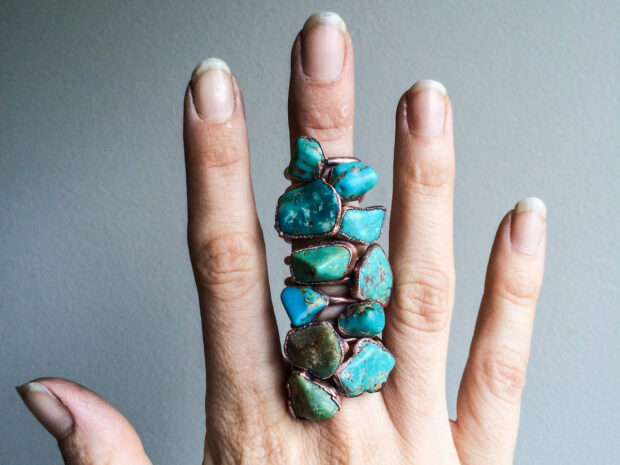For tens of thousands of years, humans have been adorning their bodies with stones that caught their attention. From vibrant colors to the way the light sparkled in and around these stones, gemstones have separated themselves from an ordinary rock since the beginning.
The beauty of gemstones is due to their atoms and molecules that line up in a particular way. Sometimes it’s an extremely precise way. For example, the way carbon atoms line up in a diamond gives the gem its hardness and its ability to bounce light around inside it. If the carbon atoms are lined up any other way, the material becomes the soft graphite of a pencil nib or a lump of coal.

Diamonds are just one example of gemstones we have come to know and love, but what about the other gemstones? Here’s a quick guide to help you understand gemstones when you decide to purchase your next piece of jewelry.
Grouping Gemstones
Gemstones are grouped in many ways. Some gemologists group them according to how valuable they are. They would, for example, place diamonds, rubies, sapphires and emeralds in one group, since these are the most sought after gems.
Other types of groupings depend on what the gem is made of. Besides the pure carbon that is a diamond, there are sulfide gems such as pyrite and marcasite. Silicates are a large family of gems that include zircon, garnet, and topaz. Beryl, which includes emerald and aquamarine, is a subfamily in the silicate family as are quartz gems such as amethyst and citrine. Chalcedony also belongs to the silicate family.
Gemstones can be synthetics or organics. Synthetics can be made to resemble just about any natural gemstone. Organics include pearls, coral, amber, jet, and various types of shells.
Properties of Gemstones
Hardness
Hardness can determine how the gem should be cut and polished or whether it is tough enough to be worn as jewelry at all. There are several scales that determine the hardness of a gemstone, but one that is frequently used is the Mohs scale.
A diamond has a rating of 10 on the Mohs scale because it’s the hardest natural substance known to humans. On the other hand, lepidolite has a hardness of 2.5 to 4. It’s so soft that sheets of this gemstone can actually bend then bounce back to their original shape.
Color
Color or colorlessness is another property of gemstones. At Diamonds Forever San Diego, gemstone professionals know that the most valuable diamond is colorless and flawless, but even diamonds can come in a wealth of colors.
These diamonds, called fancies, are judged by the intensity of their color. Their carat weight, cut, and whether they contain flaws doesn’t matter as much in fancies as it does in colorless diamonds. A brilliant, deeply red diamond that is nearly flawless and beautifully cut can cost more than a colorless diamond of the same quality.
Most gems can come in more than one color, though in some stones the color is diagnostic. Amethyst is always some shade of purple, and its cousin, aquamarine, is always a shade of blue. Emeralds are always some shade of green.
Interestingly, sapphires and rubies are basically the same gemstones. They are both made of corundum. But a ruby is always red, while a sapphire can come in any color but red.
Refractive Index
Another property to consider is a gem’s refractive index. This measures the relationship between the angle at which light hits the gem and the angle of refraction. This is how the light bends as it enters the stone.
Pyrite, for example, does not have a refractive index. The refractive index for a diamond is 2.41, which gives it a much higher refractive index than most other gemstones. Still, despite a diamond’s famous sparkle and fire, its RI is not the highest. Gems such as cuprite and hematite have higher RIs.
Density, Cleavage, and Fracture
Density is another property of a gemstone. It’s measured against the density of water, which is 1.00. Most gemstones have a higher density than water and will sink if they’re put in a vessel of pure water.
Aside from having a high RI, hematite is very dense, with a relative density between 4.9 and 5.3. Amber is just slightly denser than freshwater while it floats in seawater. This is why it’s often found washed up on the beach.
Other properties include the crystal group that a gem belongs to, as well as its cleavage. These attributes tell a gem cutter how best to cut a gemstone and whether they should cut it at all.
The cleavage shows the direction along which the stone is most easily split. A gemstone can be challenging to split because of the type of cleavage it has. If it is not split the right way, it can simply break into pieces.
When a gemstone is smashed, mineralogists speak of its fracture. Pieces of most smashed gemstones resemble shells, so their fracture is called conchoidal.
Where Gemstones are Found
Gems are found all over the world, but there are places where they are concentrated. Often, they are found in ores and are mined with other gemstones and useful minerals or elements. You can find concentrations of gemstones in places like Brazil, Myanmar, Sri Lanka, India, South Africa, Australia and many African countries.
The post Buying Gemstone Jewelry? Here’s a Quick Guide To The Popular Stones appeared first on Style Motivation.
Buying Gemstone Jewelry? Here’s a Quick Guide To The Popular Stones posted first on http://www.stylemotivation.com
No comments:
Post a Comment